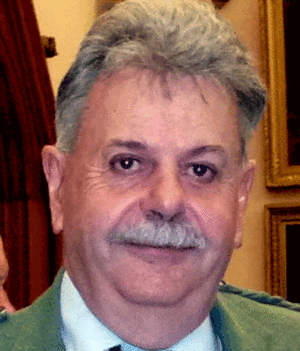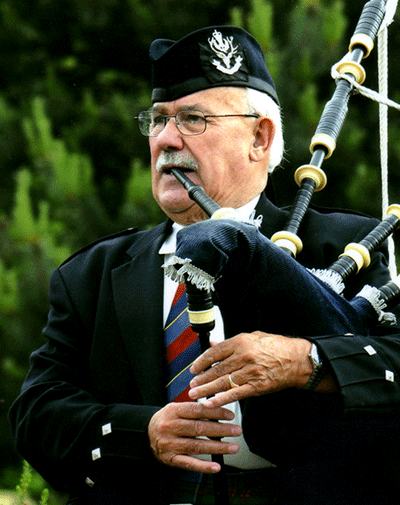
This story has a starting date. It seems that John Macdonald MBE (Inverness) was presented with a pipe chanter in 1942, some 81 years ago. He was about 76 years of age at the time and would have ceased playing in competition.
I don’t know why he was presented with the chanter. Perhaps piping historians have the information. He was awarded the MBE in 1932 and died in 1953.

By Duncan Watson
Enter the late John Stewart who served as a policeman firstly in Aberdeen City Police and finally in Grampian Police. He was Pipe Major of the Grampian Police Pipe Band for seven years. He was successful in solo piping and won the Braemar Gold Medal for Piobaireachd in 1969, and before his death was a popular judge.
A native of Aviemore, Strathspey and Badenoch, John, as a young lad, had a few lessons from John Macdonald. In truth, John Stewart indicated to me that at the time, and being so young, he did not really appreciate the significance of what he was being shown, or that John Macdonald was the leading authority on ceòl mòr.
He admitted he did not learn a great deal from the experience, but one can imagine the situation of the young teenager getting his lessons from the reputedly stern teacher. In any case, the memories of the sessions remained with John throughout his life and, his interest in piobaireachd established, he later became a pupil of Robert U Brown and Robert B Nicol, both themselves earlier pupils of John Macdonald.
Around the year 2000, while visiting a friend, John Stewart was shown a pipe chanter on which there was a hallmarked silver engraved sole. It was/is a MacRae chanter and what made it of great interest was this engraving.
It reads, ‘Presented to PM John Macdonald MBE; Hon. Piper to the King; From Major D Manson V.D. BWRH Rgt. of Canada; Montreal 1942’. 1942 was, of course, during WW2. I assume that ‘BWRH Rgt’, stands for Black Watch Royal Highland Regiment.
On reading the inscription, John told the lady he was visiting that he had had lessons from the man named on the sole – and on that basis the chanter was given to him.
John was inquisitive about the engraving but by that time both the Bobs had died, and information about it that they may have had, had gone with them.
John tried to get the chanter going but found it difficult to get a reed which would produce an acceptable sound. In all probability, John Macdonald seems to have had the same problem as it appears that the chanter has been rarely, if ever, used.


I acquired the chanter on John’s passing. It was/is in very good condition and is finely finished with varnish. It is a very nice looking piece of wood with straight grain. The chanter bears the maker’s name, Duncan MacRae. I tried making reeds to suit using a variety of different sizes but couldn’t get a scale that was acceptable to the ear.
Major David Manson VD of the Canadian Army is the Major Manson celebrated in the well known 2/4 March, Major Manson at Clachantrushal, by Pipe Major Donald MacLean (Big Donald) who served in the Seaforth Highlanders during WW2.
Major David Manson served in World War 1. Pipe Major Donald MacLean was a native of Balantrushal, Isle of Lewis, and I don’t know what the connection was between those two men. It is believed that Major Manson presented a silver mounted set of bagpipes to another Lewisman, Peter R MacLeod, the famous composer of such tunes as John Morrison, Assynt House.
During his life Major David Manson was maybe a silversmith based in Glasgow, but I don’t know when.
As an aside there was another person named Major Manson who served in the Seaforths during WW2. He hailed from Caithness or Sutherland and was known as ‘The Mad Major’. Apparently this Major Manson was also a piper.
In conclusion, this tale is not so much about the persons involved, but more on how artefacts, and in particular how one such artefact, the pipe chanter, connects pipers personally and the rest of us through our common interest. I would appreciate any further information. Please email editor@pipingpress.com.

















Likely the same David Manson (born 22 JUL 1872 at Allerton near Cromarty) who served in the 1st Bn. Seaforth Highlanders prior to moving to Canada where he served in the Black Watch of Canada (from 1897?), was Pipe-Major of the 13th CEF (Black Watch) until 1917 and was then transferred to the 20th Reserve Battalion at Bramshott. He was commissioned as an officer in January 1918 and later reached the rank of Major. Passed away in 1959. Piper, highland dancer and piping judge.